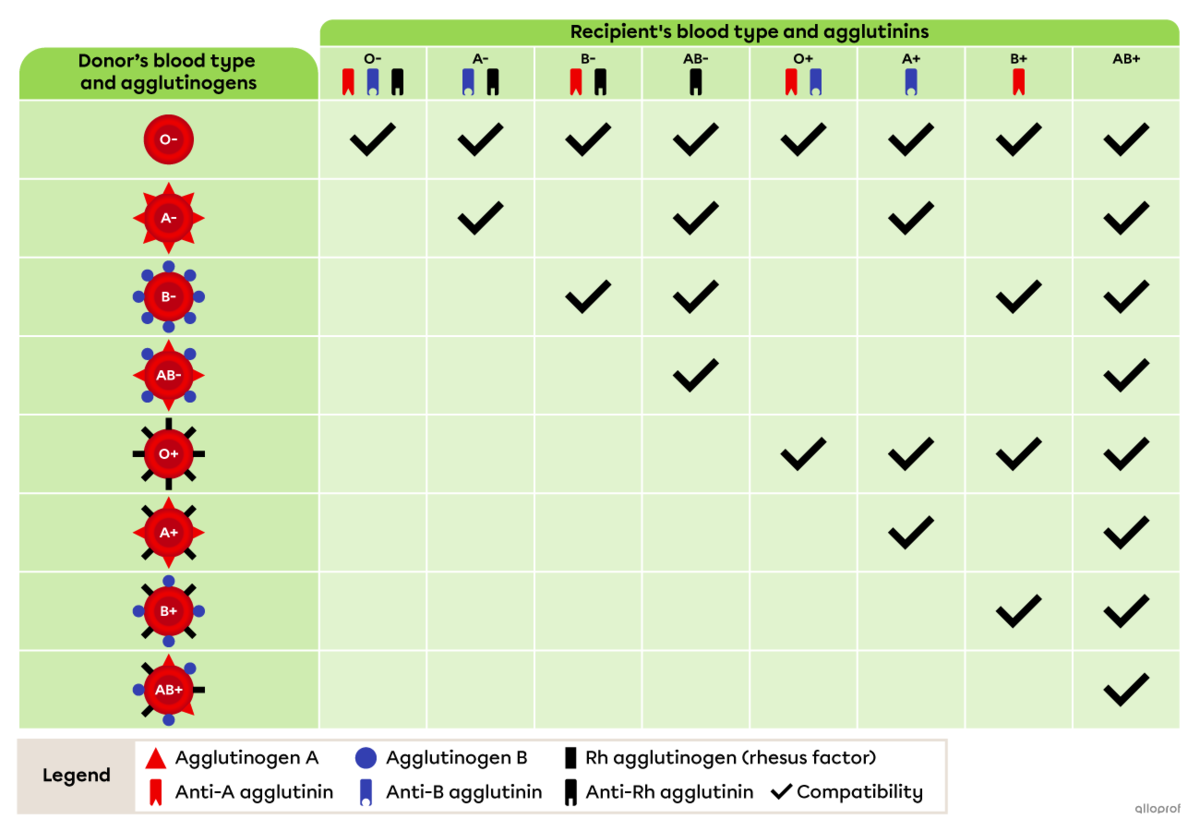Blood Types and Compatibility
Blood Types
A person's blood type is determined by the presence or absence of antigens on the surface of their red blood cells. These small proteins are called agglutinogens.
-
An antigen is a protein that can trigger an immune response when introduced into an organism where it is foreign.
-
Agglutinogens are antigens found on red blood cells.
Be careful!
It is important to distinguish between the terms antigen, agglutinogen, antibody and agglutinin.
The main agglutinogens are agglutinogen A, agglutinogen B and the rhesus (Rh) agglutinogen, also known as the rhesus factor or simply Rh factor.
The presence or absence of these agglutinogens differentiates 8 blood types. Each type is named according to the agglutinogens present on the surface of the red blood cells.
-
Type O-: No agglutinogens
-
Type O+: Rh agglutinogens
-
Type A-: Agglutinogens A
-
Type A+: Agglutinogens A and Rh
-
Type B-: Agglutinogens B
-
Type B+: Agglutinogens B and Rh
-
Type AB-: Agglutinogens A and B
-
Type AB+: Agglutinogens A, B and Rh
To represent these small proteins, shapes are usually used. Throughout this concept sheet, agglutinogens A are represented by red triangles, agglutinogens B are represented by blue circles and the Rh agglutinogens (rhesus factor) are represented by black rectangles.

Agglutinogens in each blood type
Which agglutinogens are found on the red blood cells of a person with A+ blood type?
See solution
Using the following legend, represent a red blood cell of the B- blood type.

See solution
Blood Compatibility
The blood compatibility between a donor and a recipient is determined by the presence or absence of antibodies in the recipient's plasma. These small proteins are called agglutinins and can cause the agglutination or clumping of red blood cells.
-
Blood compatibility is the ability to perform transfusions of blood products between two people without causing an immune reaction in the recipient.
-
The donor is the person whose blood products, such as red blood cells, are taken.
-
The recipient is the person who receives the donor's blood products.
-
An antibody is a protein that can trigger an immune response when it recognizes the presence of foreign antigens.
-
Agglutinins are antibodies found in plasma.
-
Agglutination is the clumping of red blood cells.
Be careful!
It is important to distinguish between the terms antibody, agglutinin, antigen and agglutinogen.
The main agglutinins are anti-A agglutinin (or agglutinin A), anti-B agglutinin (or agglutinin B) and anti-rhesus (anti-Rh) agglutinin (or agglutinin Rh). Each type of agglutinin reacts to a corresponding type of agglutinogen.
-
Anti-A agglutinin reacts in the presence of agglutinogen A.
-
Anti-B agglutinin reacts in the presence of agglutinogen B.
-
Anti-Rh agglutinin reacts in the presence of Rh agglutinogen (rhesus factor).
Agglutinins are represented by a complementary shape to their corresponding agglutinogen.

Agglutinins and their corresponding agglutinogens
A person's plasma usually contains agglutinins corresponding to agglutinogens that are not found on their own red blood cells.
A person with A+ blood type has both agglutinogens A and agglutinogens Rh on their red blood cells.
Since there are no agglutinogens B on their red blood cells, their plasma contains anti-B agglutinins. These agglutinins would cause the agglutination of red blood cells carrying agglutinogens B.

What agglutinins are present in the plasma of a person with O+ blood type?
See solution
The following image shows the agglutinins in the plasma of each blood type.

A red blood cell of each blood type and its plasma agglutinins
During a blood transfusion, red blood cells from the donor are introduced into the recipient's body. The immune reaction caused by the transfusion of incompatible blood products can be severe.
Important!
In order to avoid an immune reaction in the recipient, the donor's red blood cells can not have agglutinogens corresponding to the recipient's agglutinins.
A type A- donor has only agglutinogens A on their red blood cells and a type A+ recipient has no anti-A agglutinins in their plasma. The recipient has only anti-B agglutinins.
The donor does not have the agglutinogens corresponding to the recipient's agglutinins. A donor of type A- is therefore compatible with a recipient of type A+. This means that red blood cells of type A- can be given to a person of type A+ without any immune reaction in the recipient.

A type A- donor has only A agglutinogens on their red blood cells and a type B- recipient has anti-A agglutinins (as well as anti-Rh agglutinins) in their plasma.
The donor has agglutinogens corresponding to the recipient's agglutinins. A type A- donor is therefore incompatible with a type B- recipient. This means that red blood cells of type A- cannot be transmitted to a person of type B-, as the recipient would suffer an immune reaction.

The following table summarizes the compatibility between blood types.

Blood type compatibility
Notes:
- The O- blood type has no agglutinogens on its red blood cells. It is called a universal donor, because all blood types can receive blood of type O-.
-
The AB+ blood type has no agglutinins in its plasma. The person is called a universal recipient, because they can receive blood of all types.
Find out more!
Anti-A and anti-B agglutinins are natural antibodies. For example, a baby with blood type A develops anti-B agglutinins in the blood plasma in the first few months of life. Similarly, a baby with blood type B develops anti-A agglutinins in the plasma.
On the other hand, anti-Rh agglutinins are not necessarily present in the blood plasma of an Rh negative person. Anti-Rh agglutinins are acquired antibodies. An individual with Rh-negative blood can produce Rh agglutinins following an event, such as a transfusion of incompatible blood (Rh+ blood) or a pregnancy (fetus with Rh+ blood).
Video

